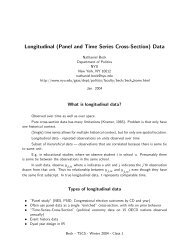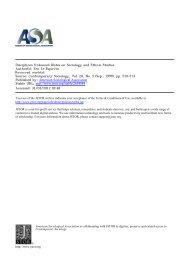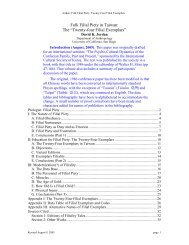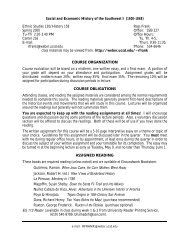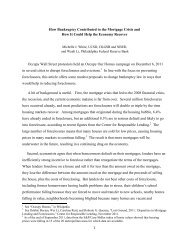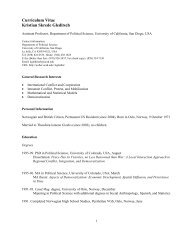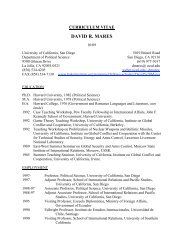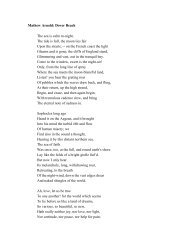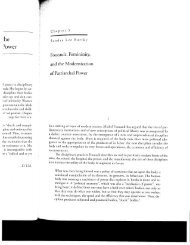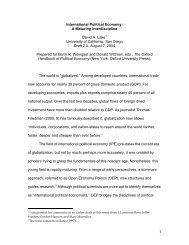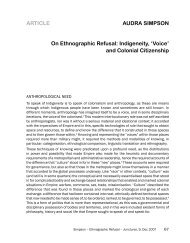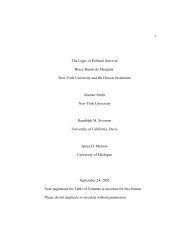Climate change and water resources in the Murray Darling Basin ...
Climate change and water resources in the Murray Darling Basin ...
Climate change and water resources in the Murray Darling Basin ...
You also want an ePaper? Increase the reach of your titles
YUMPU automatically turns print PDFs into web optimized ePapers that Google loves.
ABARE CONFERENCE PAPER 02.11<br />
A moderate <strong>in</strong>crease <strong>in</strong> <strong>the</strong> rate of global warm<strong>in</strong>g was projected to result <strong>in</strong> a substantial<br />
decl<strong>in</strong>e <strong>in</strong> river flows <strong>and</strong> economic returns. River flows were between 8 <strong>and</strong> 18 per cent<br />
lower under <strong>the</strong> SRES A1 scenario <strong>in</strong> comparison with <strong>the</strong> SRES B1 scenario, <strong>and</strong> overall<br />
economic returns were 33 per cent lower. However, an <strong>in</strong>creased rate of global warm<strong>in</strong>g<br />
under <strong>the</strong> SRES A1 scenario did not result <strong>in</strong> uniformly worse environmental outcomes.<br />
The drier climate under <strong>the</strong> SRES A1 scenario resulted <strong>in</strong> a greater decrease <strong>in</strong> irrigation<br />
that led to a larger reduction <strong>in</strong> recharge than <strong>the</strong> SRES B1 scenario. This resulted <strong>in</strong> a<br />
larger improvement <strong>in</strong> <strong>water</strong> quality <strong>in</strong> <strong>the</strong> <strong>Murray</strong> River even though it tended to generate<br />
more adverse affects on catchment runoff. The area affected by high <strong>water</strong> tables was<br />
lower <strong>in</strong> <strong>the</strong> drier climate simulated under <strong>the</strong> SRES A1 scenario.<br />
When <strong>the</strong> uncerta<strong>in</strong>ty <strong>in</strong>herent <strong>in</strong> <strong>the</strong> SRES scenarios is coupled with <strong>the</strong> unknowns associated<br />
with regional climate projections, <strong>change</strong>s <strong>in</strong> surface <strong>water</strong> yields, ground <strong>water</strong><br />
systems <strong>and</strong> crop yields, any direct concern about <strong>the</strong> specific range of outcomes appears<br />
unwarranted. The fact that climate <strong>change</strong> can generate significant <strong>change</strong>s <strong>in</strong> both<br />
economic <strong>and</strong> environmental outcomes at a regional scale adds to <strong>the</strong> risk associated with<br />
longer term public <strong>and</strong> private <strong>in</strong>vestments. At <strong>the</strong> same time, it <strong>in</strong>creases <strong>the</strong> value associated<br />
with <strong>the</strong> capacity to adapt to <strong>change</strong>s <strong>in</strong> <strong>the</strong> physical environment.<br />
Build<strong>in</strong>g <strong>the</strong> capacity to adapt may take <strong>the</strong> form of more flexible <strong>in</strong>stitutional arrangements<br />
to facilitate <strong>the</strong> efficient reallocation of <strong>resources</strong>, <strong>in</strong>vest<strong>in</strong>g <strong>in</strong> options such as<br />
<strong>in</strong>creased conservation of ground <strong>water</strong> <strong>and</strong> o<strong>the</strong>r <strong>resources</strong>. Any potential adaptations<br />
will need to be supported by research <strong>in</strong> both hydrological <strong>and</strong> agronomic responses to<br />
enhanced greenhouse conditions. Capacity build<strong>in</strong>g is not costless. However, <strong>the</strong> impetus<br />
created by <strong>the</strong> potential impacts of climate <strong>change</strong> may simply re<strong>in</strong>force a broad set of<br />
<strong>in</strong>centives to exp<strong>and</strong> our capacity to adapt to a chang<strong>in</strong>g environment <strong>and</strong> social concerns<br />
for that environment.<br />
The adaptation simulations that were explored with<strong>in</strong> this study suggest that <strong>water</strong> trade<br />
<strong>and</strong> <strong>the</strong> capacity to <strong>in</strong>crease <strong>water</strong> use efficiency can significantly mitigate <strong>the</strong> effects of a<br />
drier climate. Both <strong>water</strong> trade <strong>and</strong> <strong>the</strong> <strong>in</strong>centive for <strong>in</strong>vest<strong>in</strong>g <strong>in</strong> <strong>the</strong> <strong>in</strong>frastructure required<br />
to improve <strong>the</strong> efficiency of <strong>water</strong> use require well def<strong>in</strong>ed <strong>and</strong> secure property rights to<br />
achieve <strong>the</strong> maximum economic benefit. Fur<strong>the</strong>r, <strong>water</strong> trade has <strong>the</strong> capacity to generate<br />
both positive <strong>and</strong> negative downstream benefits to both consumptive <strong>water</strong> users <strong>and</strong> <strong>the</strong><br />
environment. Institutional arrangements that govern trade will need to take <strong>the</strong>se externalities<br />
<strong>in</strong>to account. Property rights have been <strong>the</strong> central issue <strong>in</strong> <strong>the</strong> <strong>water</strong> reform debate<br />
<strong>in</strong> Australia, <strong>and</strong> with <strong>in</strong>creas<strong>in</strong>g concern for river <strong>and</strong> stream health, <strong>the</strong> debate is likely to<br />
<strong>in</strong>tensify.<br />
29




